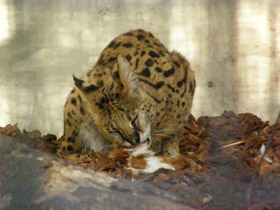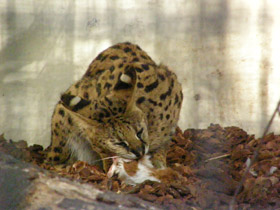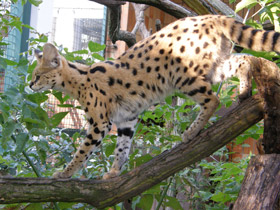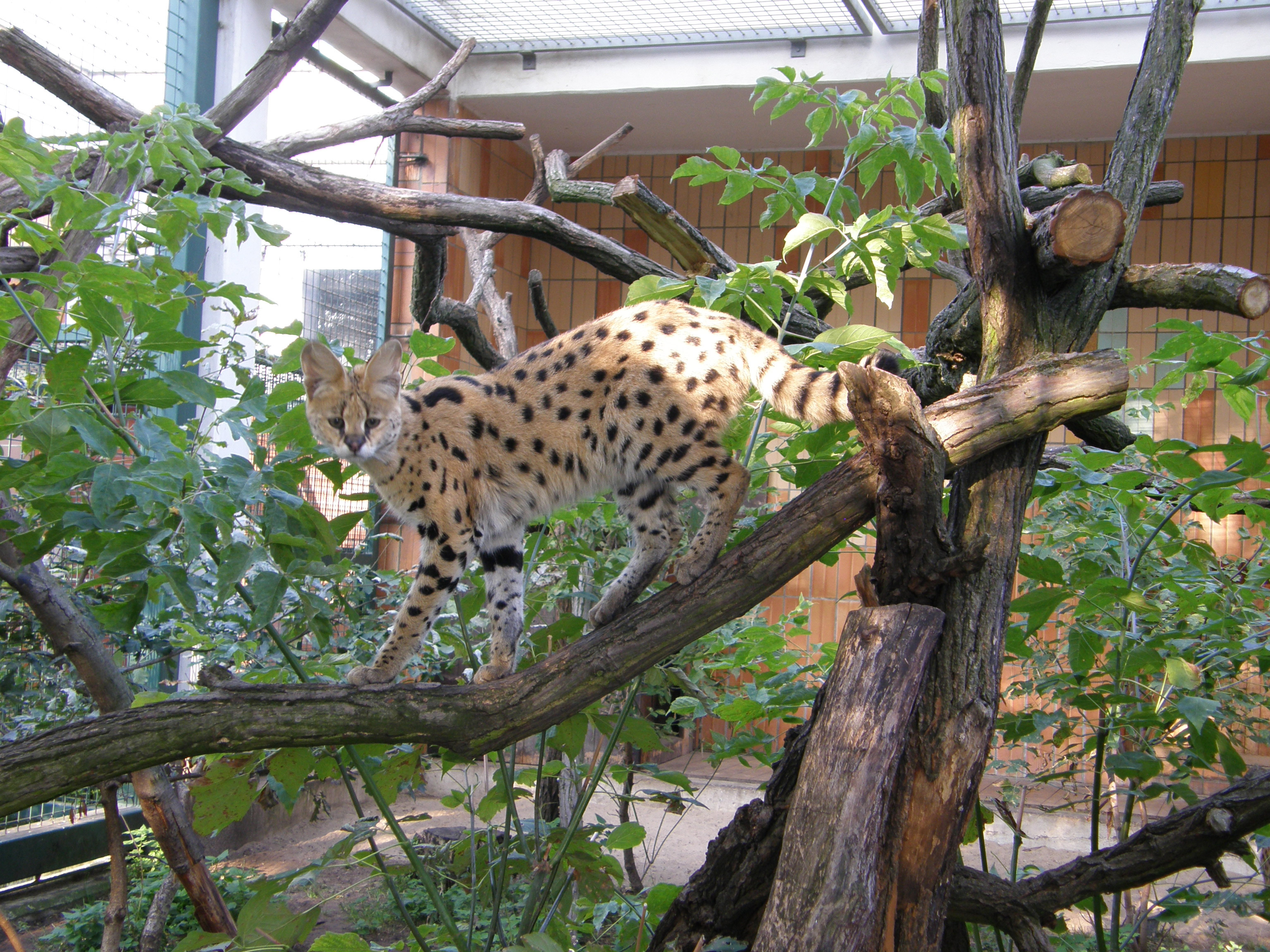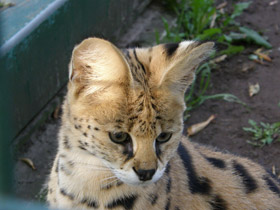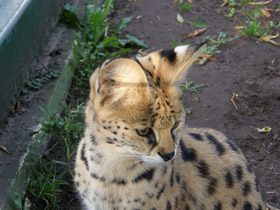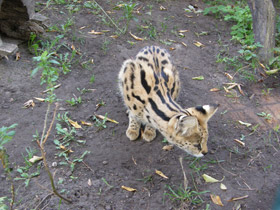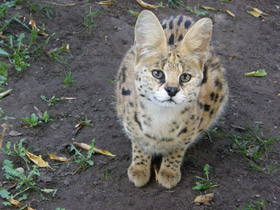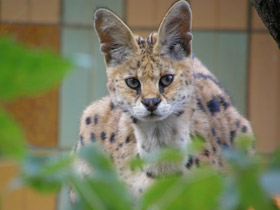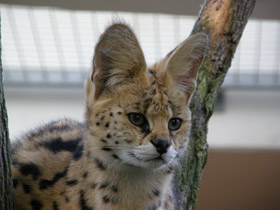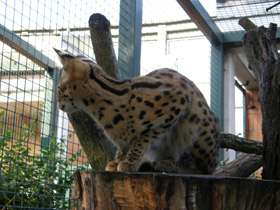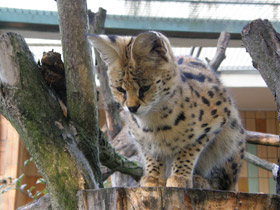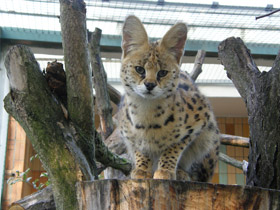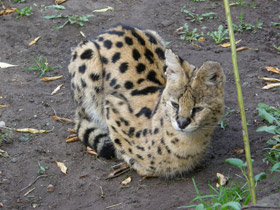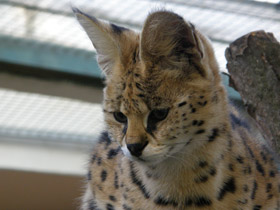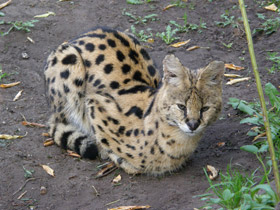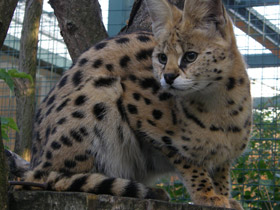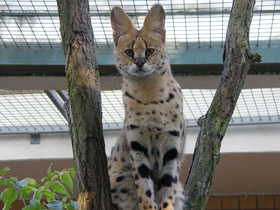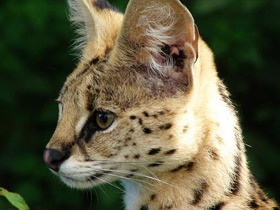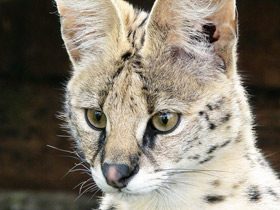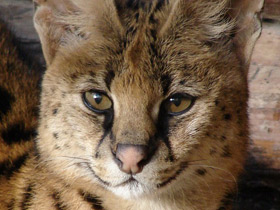The serval (Leptailurus serval)
Serval видео
The serval (Leptailurus serval) is a wild cat native to Africa. It is widespread in sub-Saharan countries, except rainforest regions. Across its range, it occurs in protected areas, and hunting it is either prohibited or regulated in range countries.
Appearance
Leptailurus serval is a species of carnivorous mammal in the family Felidae. It is the only felid species of its genus.
Leptailurus serval is a medium-sized, slender, long-legged cat. It is between 65 and 100 cm long and up to 60 cm at the withers, but weighs only about 20 kg. The serval's appearance is rather peculiar: it has the tallest legs and the largest ears (in relation to body size) of all felines. The head is disproportionately small and the tail is rather short (25-40 cm).
Due to a number of morphological characteristics, Leptailurus serval is considered a close relative of the lynx and the caracal, although its colouring resembles mainly that of the cheetah. Inhabiting the forests and savannahs of Morocco, Tunisia and South Africa, the serval is known locally as the "giraffe cat", which is an eloquent description of its stature. The light brown fur of Leptailurus serval, with darker patches, provides the perfect camouflage for remaining virtually invisible among the sunburnt savannah vegetation.
Each Leptailurus serval has a unique and distinctive coat pattern. Another peculiarity is the white stripes on the back of the ears. Zoologists believe that these white eye-shaped spots, which protrude from the surface of the grass, are useful for the young juveniles to go out hunting with their mother and not lose sight of her.
Habitat
Leptailurus serval is distributed throughout most of Africa, excluding the Sahara, equatorial forests and the southern tip of the continent (Cape Province). North of the Sahara (Algeria, Morocco) this animal is now extremely rare, but it is still quite common in East and West Africa. The largest population of this cat is found in the famous Ngoro-Ngoro crater (Tanzania), with a population density of up to 40 animals per 100 km2. Leptailurus serval inhabit open spaces with bush and grass thickets, and tend to settle near water. They avoid deserts, dry plains and tropical rainforests, sticking to the edges of the latter.
Etymology
The name "serval" is derived from (lobo-) cerval, i.e. Portuguese for lynx, used by Georges-Louis Leclerc, Comte de Buffon in 1765 for a spotted cat that was kept at the time in the Royal Menagerie in Versailles; lobo-cerval is derived from Latin lupus cervarius, literally and respectively "wolf" and "of or pertaining to deer".
The name Leptailurus derives from the Greek λεπτός leptós meaning "fine, delicate", and αἴλουρος aílouros meaning "cat".
Taxonomy
Felis serval was first described by Johann Christian Daniel von Schreber in 1776. In the 19th and 20th centuries, the following serval zoological specimens were described:
- Felis constantina proposed by Georg Forster in 1780 was a specimen from the vicinity of Constantine, Algeria.
- Felis servalina proposed by William Ogilby in 1839 was based on one serval skin from Sierra Leone with freckle-sized spots.
- Felis brachyura proposed by Johann Andreas Wagner in 1841 was also a serval skin from Sierra Leone.
- Felis (Serval) togoensis proposed by Paul Matschie in 1893 were two skins and three skulls from Togo.
- Felis servalina pantasticta and F. s. liposticta proposed by Reginald Innes Pocock in 1907 were based on one serval from Entebbe in Uganda with a yellowish fur, and one serval skin from Mombasa in Kenya with dusky spots on its belly.
- Felis capensis phillipsi proposed by Glover Morrill Allen in 1914 was a skin and a skeleton of an adult male serval from El Garef at the Blue Nile in Sudan.
The generic name Leptailurus was proposed by Nikolai Severtzov in 1858. The serval is the sole member of this genus.
In 1944, Pocock recognised three serval races in North Africa. Three subspecies are recognised as valid since 2017:
- Leptailurus serval serval, the nominate subspecies, in Southern Africa;
- Leptailurus serval constantina in Central and West Africa;
- Leptailurus serval lipostictus in East Africa.
Lifestyle and nutrition
Leptailurus serval is active mainly at dusk and at night. Ninety percent of their menu consists of prey weighing no more than 200 grams, of which rodents make up the majority. They also feed on hares, hyraxes and small antelopes, as well as various birds (flamingos, guinea fowl) and even frogs. Sometimes Leptailurus serval also feeds on vegetation to obtain minerals and crude fibre from it, but rarely eats carrion.
Their large ears and well-developed hearing help these carnivores track rodents and lizards, while their long limbs make it easier for them to move through and look over the tall grasses of the savannah.
Leptailurus serval can travel three to five kilometres in search of prey, but is not capable of a long chase. Its hunting strategies are varied. It digs rodents out of holes, can climb tall trees in search of hyraxes and bring down flying birds with a vertical leap of up to three metres. But the preferred hunting method of the Leptailurus serval is to wait for prey by lurking in dense grass. Its colouring and silent movements allow the serval to sneak up and remain undetected by its prey until the last moment, and then attack from behind.
Unlike its relative the cheetah, the serval does not stalk its prey, but uses the element of surprise to leap into ambush, pinning its prey to the ground with its weight and then grabbing it by the throat before it remembers. Such a tactic is very effective, allowing Leptailurus serval to succeed in one case out of two, whereas most felines succeed in only one case out of five or six. This predator is so agile and malleable that it can leap more than three and a half metres from a standing position and its long legs allow it to reach speeds of up to 80 km/h.
The Leptailurus serval leads a solitary life, finding mates only for the short breeding season. Leptailurus servalis mark their territory and remain there for many years. When defending themselves, they prefer not to confront their opponents openly, but use a system of warning signals: hissing, body position and ear position. In case of danger, Leptailurus serval prefer to hide or flee by unexpectedly jumping or abruptly changing running direction, and less often by climbing trees. Leptailurus serval can easily swim through an unexpected obstacle to safety in the form of a river.
Reproduction
Leptailurus serval has a gestation period of 65 to 75 days. The young are born in old tube-tooth burrows or in nests in the grass; on average, there are 2-3 blind, helpless kittens in a litter. The mother feeds them with milk for 5 to 7.5 months. At one year of age, they leave their mother and seek their own territory. Young females live with their mothers longer than young males.
Leptailurus serval reach sexual maturity between 18 and 24 months of age.
Conservation
The degradation of wetlands and grasslands is a major threat to the survival of the serval. Trade of serval skins, though on the decline, still occurs in countries such as Benin and Senegal. In West Africa, the serval has significance in traditional medicine. Pastoralists often kill servals to protect their livestock, though servals generally do not prey on livestock.
The serval is listed as least concern on the IUCN Red List, and is included in CITES Appendix II. It occurs in several protected areas across its range. Hunting of servals is prohibited in Algeria, Botswana, Congo, Kenya, Liberia, Morocco, Mozambique, Nigeria, Rwanda, Tunisia, and South Africa's Cape Province; hunting regulations apply in Angola, Burkina Faso, Central African Republic, the Democratic Republic of the Congo, Ghana, Malawi, Senegal, Sierra Leone, Somalia, Tanzania, Togo, and Zambia.
In culture
The association of servals with human beings dates to the time of Ancient Egypt. Servals are depicted as gifts or traded objects from Nubia in Egyptian art.
Servals are occasionally kept as pets, although their wild nature means that ownership of servals is regulated in some countries.

















